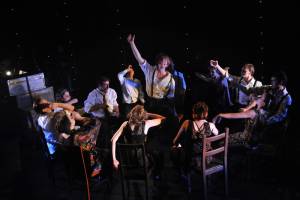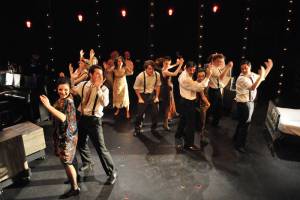
USC’s Musical Theatre Repertory’s production of Andrew Lippa’s The Wild Party is a thrilling endeavor which serves as further evidence of the brilliant directorial vision of Steve Edlund (Sunday In The Park With George) and as a preview of some very exciting professional careers ahead.
Lippa’s off-Broadway Wild Party, like its Broadway counterpart (Michael John LaChiusa’s version of the same epic 1928 poem by Joseph Moncure March), centers on an all-night party which turns into orgy which turns to tragedy. Edlund conceives his production as a dream-turned-nightmare, allowing him to spotlight his twelve-actor ensemble almost as frequently as Lippa’s book and songs do the musical’s four lead characters, keeping the party guests ever-present, surrounding Queenie, Burrs, Kate, and Black like demons.
Flashes of Edlund’s imagination are everywhere, from the opening number which features the cast “A Chorus Line”-d-up, holding not headshots but mug shot numbers (following their post-party arrest), to its closing moments when the party guests find themselves once again in line, about to spend then night in jail as punishment for their wildness.
Edlund’s Wild Party is visually stunning (kudos to Sara Nishida’s dramatic lighting) from our first view of saxophonist David Olivas illuminated by a single spot, to the cast surrounding Queenie (Briga Heelan) with hand-held lightbulbs, to the bright police headlights which appear suddenly as the cops arrive to arrest the hung-over partiers.
Talk about a busy ensemble. As Burrs (Chase Williamson) sits on a chair masturbating, the entire cast surround him, lifting him up as if he were on a boat on a rolling sea, then encircle the bed, witnesses to his rape of lover Queenie, and later, when he threatens her with a knife, they pursue him offstage like a pack of wild dogs. The bed becomes a 1920s roadster as the partygoers head towards Queenie and Burrs’ flat, introducing themselves to us, the front two party guests holding flashlights as the car’s headlamps. Whether interacting, forming couples, or surrounding the bed of a newly-coupled pair of lovers, the cast remains an integral part of the action. Only at rare, quiet moments does the ensemble retreat to upstage chairs for a break.
Choreography (by Edlund and Lili Fuller) rates an A+, with the high energy “Let’s Raise The Roof” and “The Juggernaut” standouts, featuring the entire cast executing complex, erotic, full-body moves in perfect sync. (Note—the orgy sequence which in some other productions has the cast’s near naked bodies entwined is staged here in a manner to insure that parents of the performers need not fear seeing their children in X-rated poses.) In addition to Edlund and Fuller’s spectacular dances, Joe Sofranko has choreographed a dramatic fight sequence between Burrs and Eddie with some great slo-mo effects.
Musical director Brian P. Kennedy has assembled a stellar six-piece orchestra with Kennedy on piano, Mandy Mamlet on keyboard, sax player Olivas doubling on flute, Kenneth Johnson on bass, Gavin Salmon on drums, and Erik Miron on guitar, all of whom perform Lippa’s omnipresent score to perfection. If there’s a disadvantage to having so many instruments on stage, it’s that the unmiked singers often have to push too hard to be heard above the musicians, something that does not always show off their voices to their best advantage. Since important dialog and lyrics are also sometimes drowned out by the band’s volume, body mikes would make the production sound considerably better.
As Queenie, the gorgeous, voluptuous Heelan does intense, committed work, with her performance of the closing number, “How Did We Come To This?” a triumph of musical theater acting/singing. Though Heelan’s singing suffers from being unmiked in “Let’s Raise The Roof,” her “Maybe I Like It That Way” (with simply Heelan on vocals and Kennedy on piano) is sung with beauty and power.
Though Williamson is perhaps not as menacing as Burrs could be, he is excellent at showing Queenie’s lover’s mental instability. The song “What Is It About Her?” provides a fine vocal showcase for the handsome young actor/singer, and when he goes berserk in “Let Me Drown,” the cast once again encircling him demonically, Williamson proves that the crazier Burrs gets, the better his performance becomes.
In a complete turnabout from her StageSceneLA Best of 2007-8-cited performance as Dot in Sunday In The Park With George, Natalie Peyser makes Kate makes a firecracker of manic energy. She is sexy indeed lying atop the upright piano flirting with the pianist Kennedy and a powerhouse as she belts out “The Life Of The Party.”
As Black, Garland Hunt Jr. has a voice of velvet (his “When You Cry” may well bring tears to your eyes) and a suaveness, strength, and tenderness that prove a perfect counterpoint to Burrs’ mania.
The plum role of predatory lesbian Madeline True goes to scene-stealing Laura Darrell, unrecognizable as ingénue Maria in MTLA’s West Side Story with her scary white-streaked hair and a hip she throws out to audience delight. Whether milking her solo (“An Old-Fashioned Love Story”) for everything it’s worth or turning bright green with jealousy when she finds a female object of her lust making out with a man, Darrell gives one of her most memorable performances yet.
Equally scene-stealing is adorable co-choreographer Fuller, a sizzling pixie with a Betty Boop soprano in the role of Mae, girlfriend of pugilist Eddie (MTR regular Ben Trustman, who manages to be both scary and funny at once when asking “Are you making fun of me?!”) Their number, “Two Of A Kind,” sparkles like an old-time vaudeville routine.
Completing the ensemble are Michael Marchak (Jackie), doing a beautiful “morning after” ballet dance solo to “Jackie’s Last Dance,” and triple-threats Jeffrey Watson (Oscar D’Armano), Kenton Chen (a standout as Phil D’Armano), Adam North (Sam Himelsteen), Rachel Salzman (Rose Himelsteen), Cameron Ernst (Max), Hayley Huntley (Nadien), Emily Iscoff-Daigian (Dolores) and Mary Kate Wiles (Sally).
Edlund’s set/prop design features piles of steamer trunks (and a bed of course), all on rollers to be moved here and there on the black-walled stage by cast members taking us to various nooks and crannies in Queenie and Burrs’ apartment. Costumes by Fuller and Peyser and hair design by Bernadette Tyra capture the look and feel of the decadent Roaring 20s. Sean Kranz’s sound design incorporates sirens and the tinkling of Kate’s tinkle (good for several laughs).
As a musical, The Wild Party doesn’t last nearly as long as Queenie and Burrs’ party itself, but it does clock in at over two and a half hours. Fear not, though. There’s nary a dull moment in an evening filled with passion and power. Here’s hoping that Steve Edlund won’t have to wait to long to make his professional directorial debut. 21st Century theater needs more artists of his caliber, and if The Wild Party is any example, it is a thrilling indication of great things to come.
Massman Theatre (at USC), 1029 Childs Way, Los Angeles
http://uscmtr.weebly.com
–Steven Stanley
January 21, 2009
Photos: Zack DeZon







 Since 2007, Steven Stanley's StageSceneLA.com has spotlighted the best in Southern California theater via reviews, interviews, and its annual StageSceneLA Scenies.
Since 2007, Steven Stanley's StageSceneLA.com has spotlighted the best in Southern California theater via reviews, interviews, and its annual StageSceneLA Scenies.







 COPYRIGHT 2024 STEVEN STANLEY :: DESIGN BY
COPYRIGHT 2024 STEVEN STANLEY :: DESIGN BY